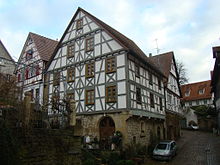Bad Wimpfen Jewish community
A Jewish community in Bad Wimpfen probably already existed in the 13th century. Apart from short-term expulsions had always small community to the German deportation Jews to the Nazi era stock.
history
An early-mentioned Jew who probably came from Wimpfen was the Frankfurt merchant Alexander ben Salomon Wimpfen , also known as Süßkind Wimpfen , who in 1307, shortly before his death, released the bones of Rabbi Meir von Rothenburg , who died in 1293 . Both are buried in the Heiliger Sand cemetery in Worms , where Wimpfen Jews were related in later centuries.
In 1327 a Judenhaus and a Judengasse in Wimpfen are mentioned, in the 14th and 15th centuries there was also an old Judengasse near the Gasthaus Krone and a Jewish school . In the early 16th century there was temporarily only one Jewish family in Wimpfen. Around 1540 there were efforts by the Teutonic Order , which owned areas around Wimpfen, to expel Jews not only from the order area, but also from surrounding rulers. Around 1550 the expulsion of Jews is documented in Wimpfen, but various Jews lived there in the future, including the Jew Alexander, son of Lemle, who built a house on the Burgstaffel in the former Pfalz Wimpfen in 1580 , which was later also used as a prayer room .
There were various orders of the Jews , the oldest from 1598 , others from 1626, 1630, 1756 and 1762, which imposed the usual restrictions on the Jews. The Jewish ordinances of 1626 and 1630 limited the number of Jewish families living in Wimpfen am Berg to four. From 1626 to 1630, Jews also had to identify themselves by wearing yellow rings on their clothing. The Wimpfen Jews were forbidden to maintain a school and a synagogue; instead they had to visit the Heinsheim synagogue . The burial of the Jews in Wimpfen was originally in the large Jewish cemetery in Heinsheim .
After the Thirty Years' War , the relationship of the Teutonic Order to Jews changed, so that Jews from Wimpfen traded in the Teutonic Order area or even moved to Teutonic Order locations and obtained a letter of protection from the Teutonic Order. In 1672 the Jews were expelled from Wimpfen, which was lifted after two years. In the 18th century there was only a very small and impoverished community in Wimpfen, to which the Jewish code of 1756 only granted a single house. After the end of the imperial city period, the multiple previous restrictions fell. Wimpfen came to Hessen in 1802/03. In 1805, house ownership was made easier for Jews in Hesse, and in 1839 Jews were granted citizenship. About 40 Jews lived in the city at that time. The community had a ritual bath in Jacob Baer's house. The burial continued to take place in Heinsheim, partly in the 19th century at the Bad Rappenau Jewish cemetery .
In 1830 the Jewish school and church services were held in the house built in 1580 on Burgstaffel / Schwibbogengasse. Even when the building was later sold to non-Jews, the owners tolerated further use for cult activities. In 1896 a Jewish cemetery was set up on the outskirts of Wimpfen . At the end of the Hessian Ministry of the Interior, an Israelite religious community was to be formed as early as 1898 when the Wimpfen Jews were assigned to the Darmstadt Rabbinate, but none of the ten eligible voters appeared, so that in 1908 there was no community of its own.
National Socialist Persecution
In 1933 there were still 22 Jews living in Wimpfen, whose rights to the prayer room were disputed and whose rights were further curtailed in 1935, particularly with regard to property. During the November pogroms of 1938 there were riots against Jews, their businesses and homes. By the summer of 1941, most of the Wimpfen Jews had managed to emigrate.
The memorial book of the Federal Archives lists 10 Jewish citizens born in Bad Wimpfen who fell victim to the genocide of the National Socialist regime .
Common names
When hereditary family names had to be adopted at the beginning of the 19th century, the heads of families of the Wimpfen Jews adopted the following names: Baer, Benedict, Dreyfuß, Hirsch, Kahn and Mannheimer.
Individual evidence
- ^ Commemorative Book - Victims of the Persecution of Jews under the National Socialist Tyranny in Germany 1933 - 1945 . Retrieved October 29, 2009.
literature
- Wolfram Angerbauer , Hans Georg Frank: Jewish communities in the district and city of Heilbronn. History, fates, documents . District of Heilbronn, Heilbronn 1986 ( series of publications of the district of Heilbronn . Volume 1)


